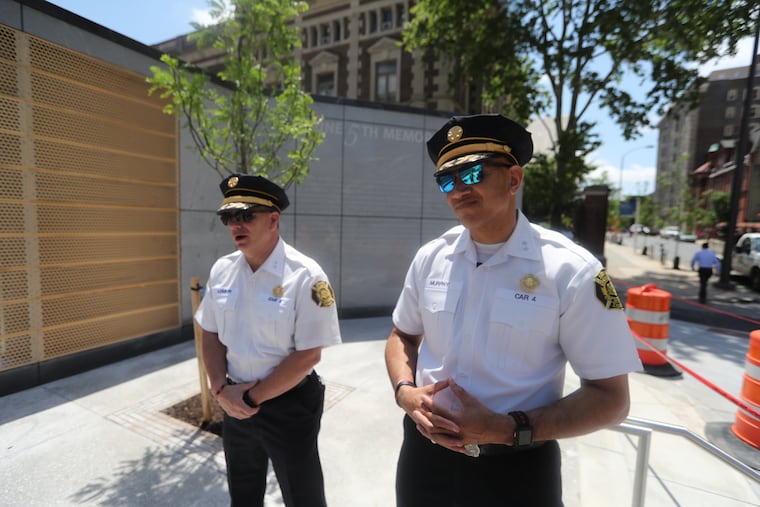‘Some disasters stand out.’ Firefighters remember the Salvation Army collapse | Ronnie Polaneczky
"But I've got to tell you, when I got there, I went numb for a minute. The size of the footprint of the site, the chaos of it, took my breath away."

On Tuesday, the city will dedicate a park on the site of one of the worst disasters in Philadelphia's history: the collapse of the Salvation Army Thrift Store at 22nd and Market Streets. The slender corner oasis — to be christened the June 5th Memorial Park in recognition of the collapse on that date in 2013 — aims to remind us of the heartache that happens when we put greed before human life.
Two men who will never need the nudge are Philadelphia Deputy Fire Commissioners Gary Loesch and Craig Murphy. They were battalion chiefs at the time — Loesch was in fire operations; Murphy was with special operations. With hundreds of other fire, rescue, police and other city personnel, they sped to the scene when the wall came down.
They think about that day every time they pass 22nd and Market, their memories as vivid as if the catastrophe happened five minutes ago, not five years.
Their brand of humble heroism is the only good thing that happened that day. Everything else was awful, serving only as evidence of how craven developers are dazzled by dollars — and risk the lives of the public and those who protect us.
"I raced down Broad Street with an aide — the reports were coming in so fast," recalls Loesch, 56, a 32-year veteran of the department. "I've been on hundreds of incidents and fires in my career. But I've got to tell you, when I got there, I went numb for a minute. The size of the footprint of the site, the chaos of it, took my breath away."
Murphy, who flew down I-95 from his headquarters near the Philadelphia Police Academy on State Road, had an idea of what was in store for his workers. As one of 18 members of the Philadelphia Fire Department who worked with first responders in New York on 9/11, he'd spent nine days helping to recover the dead and stabilize the pile of rubble the World Trade Center had become.
"When I got to Market Street, I did a 360-walk around the site, to see where we should start the rescue," recalls Murphy, 56, a 31-year veteran who as deputy commissioner oversees planning and risk reduction. "Right away, you could see there were unsupported walls in danger of collapse. We had to stabilize the site before we could begin rescue."
He had to literally pull firefighters off the pile, so frantic were they to rescue victims, one of whom was screaming for help.
"All day long, firefighters were begging me to put them to work," says Loesch, who was charged with site safety that day. "I said, I have to hold you back in case a second collapse happens. I'll need you to rescue the guys in there."
At many points throughout the operation, says Murphy, all machinery had to be shut down, generators turned off, overhead choppers banished so that rescuers could call out to victims and listen for a response.
"You need silence," says Murphy. "All that noise can work against you."
Eventually, families began showing up, fearful that missing loved ones were in the rubble. They provided rescue workers with photos and described sections of the store where their kin were likely to have been working or shopping. The FBI was able to access some victims' cell phones and make them ping, giving rescuers a clue where to dig.
"It was tedious work to de-layer the pile," says Murphy. "We didn't want to bring heavy machinery directly onto it; we didn't want to crush the remains of victims who had not survived. Their families deserved to receive them intact. It was very emotional. "
He praises the L&I worker who painstakingly worked the grabber claw of an earth mover alongside the pile, moving debris with skilled micro-movements.
"It was like the claw was his own hand," marvels Murphy.
Both Murphy and Loesch will be at the dedication of the memorial. Murphy knows it will not be his last visit. He's drawn to the places he can't forget.
"Every five years, I visit the 9/11 site," Murphy says. "It feels like the least I can do."
Loesch doesn't stay in touch with those he has helped, nor does he know any firefighter who does.
"We have to stay detached to do what we have to do," says Loesch. He's still haunted by images of two children he was unable to save in a pre-Christmas fire. They held his arms as Loesch worked frantically to remove window bars that trapped them in a burning house. "It would be too much of a burden."
Bless Loesch, Murphy and all first responders who'll never need a park to remind them of such tragedies — not when they see them clearly in their memories.